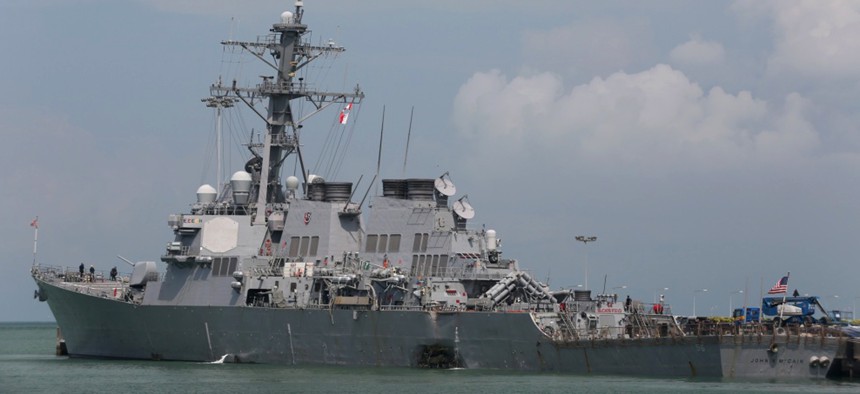
The Guided-missile destroyer USS John S. McCain (DDG 56) is moored pier side at Changi naval base in Singapore following a collision with the merchant vessel Alnic MC Monday, Aug. 21, 2017. U.S. Navy photo via AP
Our Navy is Broken, and That is a Bad Thing
The fleet’s problems stem from decades of flat acquisition budgets and declining ship numbers.
The recent string of ship collisions in the western Pacific is a clarion call to the American nation that its Navy is on the brink of combat ineffectiveness. This dismal condition is the result of a long string of irresponsible budgetary actions and strategic mistakes on the part of the nation’s leaders. While it is true that the string of mishaps has, thus far, been limited to one region of the world, the underlying contributing factors of a steady demand for 85-100 deployed ships, a shrinking fleet, and shorter and inadequately resourced maintenance and training periods are eroding the fleet’s effectiveness everywhere. The unique stresses of the western Pacific simply present the ships operating there as the canaries in the proverbial coal mine.
Americans should be alarmed. Our entire economy is supported by maritime trade. Navy ships guarantee the free navigation of the high seas. Free navigation undergirds free trade, and free trade enables access to the lower-cost goods that populate the shelves of the nation’s big-box economy. Restricted access to the world’s oceans would trigger higher prices, rapidly rising inflation and an overall weakening of the American economy. The trend towards constrained maritime commons is already evident.
Foreign development of long-range cruise and ballistic missiles threaten to block approaches to vast stretches of the open oceans, forcing both military and commercial ships to take longer routes in order to remain safe, adding both time and costs to production deliveries. Russia is seeking to establish control over the Baltic Sea, Black Sea and even portions of the Mediterranean. China is pursuing outright sovereignty over the South China and East China seas, even building artificial islands to establish illegal territorial claims. Should these claims be allowed to stand, the concepts of free navigation and free trade will erode, along with the United States’ position in the world.
The Navy’s problems stem from decades of flat acquisition budgets and declining ship numbers. The fleet has shrunk from over 500 ships at the end of the Cold War to 277 ships today. However, during this period, the Navy has been called upon to provide the same level of peacetime naval presence and wartime support, placing every increasing material strain on fleet ships and aircraft. Flat budgets with rising operational tempos have further hollowed out the fleet by siphoning off training and maintenance resources. The results of these actions can be seen in the recent parade of errors over the past few months that resulted in three collisions and one incident where a multi-billion dollar cruiser ran aground. Naval professionals attribute these errors to the conflicting demands within the current operational cycle.
Navy ships, unlike Army brigades, are continuously deployed to uphold the nation’s interests. Upon returning home from deployment a ship and enters a shipyard to replace broken equipment and make major repairs and upgrades. Following this period, the ship and its crew normally moves on to a series of training evolutions as its bridge, combat information center and engineering teams gain experience together under a range of simulated conditions. Finally, the ship deploys once again in support of established national interests.
This cycle worked well when the Navy was large enough to allow time for each of these steps to be fully accomplished, but as the fleet decreased and the demand to maintain a hundred ships forward deployed remained, time had to be taken away from either the maintenance or training schedules. A few years ago, during the height of the wars in Afghanistan and Iraq, maintenance suffered. More recently training was compromised, resulting in less experienced bridge, combat information center and engineering teams.
The solution is actually relatively simple. The Navy knows that it needs to grow its fleet. It announced last December that the minimum fleet required to protect American national interests is 355 ships. That’s also a fleet large enough to regain a balanced equilibrium in its maintenance-training-deployment cycle. The sooner the Navy can get to this number, the better. To do this, the service can bring back ships held in its ready reserve “ghost fleet,” invest in extending the lives of ships presently scheduled for decommissioning, and increase the number of ships under construction. All of these solutions will cost money and require the Congress to overturn the ill-conceived 2011 Budget Control Act and its indiscriminate sequester cuts.
There is an old proverb: “For the want of a nail, a kingdom was lost.” The fate of our Navy is about more than the nation’s defense and national security. Naval forces are the key enablers of the national economy and day-to-day life. The Navy is also the embodiment of national prestige and power. Collisions at sea and the loss of sailors’ lives is giving the nation a glimpse of its own possible future.




